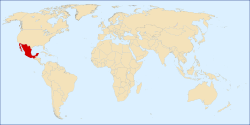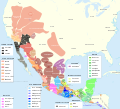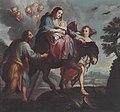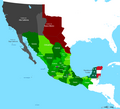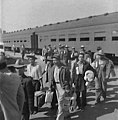Portal:Mexico
|
The Temple of Warriors at Chichen Itza, Mexico
¡Bienvenido! Welcome to the Mexico portal
Mexico, officially the United Mexican States, is a country in the southern portion of North America. It covers 1,972,550 km2 (761,610 sq mi), making it the world's 13th-largest country by area; with a population of almost 130 million, it is the 10th-most-populous country and the most populous Spanish-speaking country. Mexico is organized as a federal constitutional republic comprising 31 states and Mexico City, its capital. It shares land borders with the United States to the north, with Guatemala and Belize to the southeast; as well as maritime borders with the Pacific Ocean to the west, the Caribbean Sea to the southeast, and the Gulf of Mexico to the east.
This is a Featured article, which represents some of the best content on English Wikipedia.
 Baja California is a state in Northwest Mexico that is divided into seven municipalities. According to the 2020 Mexican census, Baja California is the 13th most populous state with 3,769,020 inhabitants and the 12th largest by land area spanning 73,290.08 square kilometres (28,297.46 sq mi). Municipalities in Baja California are administratively autonomous of the state according to the 115th article of the 1917 Constitution of Mexico. Their legal framework derives from Title VI of the state Constitution and the state's 2001 Law of the Municipal Regime. Every three years, citizens elect a municipal president (Spanish: presidente municipal) by a plurality voting system who heads a concurrently elected municipal council (ayuntamiento) responsible for providing public services for their constituents. The municipal council consists of a variable number of trustees and councillors (regidores y síndicos) who govern from the municipal seat. Municipalities are responsible for public services (such as water and sewerage), street lighting, public safety, traffic, and the maintenance of public parks, gardens and cemeteries. They may also assist the state and federal governments in education, emergency fire and medical services, environmental protection and maintenance of monuments and historical landmarks. Since 1984, they have had the power to collect property taxes and user fees, although more funds are obtained from the state and federal governments than from their own income. Municipalities may establish functional and geographical subdivisions called delegaciones and subdelegaciones in accordance with Article 29 of the Law of the Municipal Regime. (Full article...)Selected article -The Mexican–American War, also known in the United States as the Mexican War, and in Mexico as the United States intervention in Mexico, was an invasion of Mexico by the United States Army from 1846 to 1848. It followed the 1845 American annexation of Texas, which Mexico still considered its territory because Mexico refused to recognize the Treaties of Velasco, signed by President Antonio López de Santa Anna after he was captured by the Texian Army during the 1836 Texas Revolution. The Republic of Texas was de facto an independent country, but most of its Anglo-American citizens who had moved from the United States to Texas after 1822 wanted to be annexed by the United States. In the United States, sectional politics over slavery had previously prevented annexation because Texas, formerly a slavery-free territory under Mexican rule, would have been admitted as a slave state, upsetting the balance of power between Northern free states and Southern slave states. In the 1844 United States presidential election, Democrat James K. Polk was elected on a platform of expanding U.S. territory to Oregon, California (also a Mexican territory), and Texas by any means, with the 1845 annexation of Texas furthering that goal. However, the boundary between Texas and Mexico was disputed, with the Republic of Texas and the U.S. asserting it to be the Rio Grande and Mexico claiming it to be the more-northern Nueces River. Polk sent a diplomatic mission to Mexico in an attempt to buy the disputed territory, together with California and everything in-between for $25 million (equivalent to $778 million in 2023), an offer the Mexican government refused. Polk then sent a group of 80 soldiers across the disputed territory to the Rio Grande, ignoring Mexican demands to withdraw. Mexican forces interpreted this as an attack and repelled the U.S. forces on April 25, 1846, a move which Polk used to convince the Congress of the United States to declare war. (Full article...)Selected pictureThis is a Good article, an article that meets a core set of high editorial standards.
Nazario Moreno González (8 March 1970 – 9 March 2014), commonly referred to by his alias El Chayo ("Nazario" or "The Rosary") and/or El Más Loco ("The Craziest One"), was a Mexican drug lord who headed La Familia Michoacana before heading the Knights Templar Cartel, a drug cartel headquartered in the state of Michoacán. He was one of Mexico's most-wanted drug lords. Very few details are known of Moreno González's early life, but the authorities believe that religion played a major role in his upbringing. Although born in Michoacán, Moreno González moved to the United States as a teenager, but fled back into Mexico about a decade later to avoid prosecution on drug trafficking charges. In 2004, the drug boss Carlos Rosales Mendoza was captured, and Moreno González, alongside José de Jesús Méndez Vargas, took control of La Familia Michoacana. Unlike other traditional drug trafficking organizations in Mexico, his organization also operated like a religious cult, where its own members were given "bibles" with sayings and conduct guidelines. Moreno González reportedly carried out several philanthropic deeds to help the marginalized in Michoacán. Such deeds helped him craft an image of protector, saint, and Christ-like messianic figure among the poor, and gave La Familia Michoacana a level of influence among some natives. (Full article...)Selected biography -Francisco "Pancho" Villa (/ˈviːə/ VEE-ə, also US: /ˈviːjɑː/ VEE-yah; Spanish: [ˈbiʎa]; born José Doroteo Arango Arámbula, 5 June 1878 – 20 July 1923) was a Mexican revolutionary and general in the Mexican Revolution. He was a key figure in the revolutionary movement that forced out President Porfirio Díaz and brought Francisco I. Madero to power in 1911. When Madero was ousted by a coup led by General Victoriano Huerta in February 1913, Villa joined the anti-Huerta forces in the Constitutionalist Army led by Venustiano Carranza. After the defeat and exile of Huerta in July 1914, Villa broke with Carranza. Villa dominated the meeting of revolutionary generals that excluded Carranza and helped create a coalition government. Emiliano Zapata and Villa became formal allies in this period. Like Zapata, Villa was strongly in favor of land reform, but did not implement it when he had power. At the height of his power and popularity in late 1914 and early 1915, the U.S. considered recognizing Villa as Mexico's legitimate authority. Civil war broke out when Carranza challenged Villa. Villa was decisively defeated by Constitutionalist general Álvaro Obregón in summer 1915, and the U.S. aided Carranza directly against Villa in the Second Battle of Agua Prieta in November 1915. Much of Villa's army left after his defeat on the battlefield and because of his lack of resources to buy arms and pay soldiers' salaries. Angered at the U.S. aid to Carranza, Villa conducted a raid on the border town of Columbus, New Mexico to goad the U.S. into invading Mexico in 1916. Despite a major contingent of soldiers and superior military technology, the U.S. failed to capture Villa. When Carranza was ousted from power in 1920, Villa negotiated an amnesty with interim President Adolfo de la Huerta and was given a landed estate, on the condition he retire from politics. Villa was assassinated in 1923. Although his faction did not prevail in the Revolution, he was one of its most charismatic and prominent figures. (Full article...)
In the news
Selected fare or cuisine -
Crema is the Spanish word for cream. In the United States, or in the English language, it is sometimes referred to as crema espesa (English: "thick cream"), also referred to as crema fresca (English: "fresh cream") in Mexico. Crema fresca or crema espesa is a Mexican dairy product prepared with two ingredients, heavy cream and buttermilk. Salt and lime juice may also be used in its preparation. Crema's fat content can range between 18 and 36 percent. In Mexico, it is sold directly to consumers through ranches outside large cities, as well as being available in Mexican and Latin American grocery stores in the United States. Crema is used as a food topping, a condiment and as an ingredient in sauces. It is similar in texture and flavor to France's crème fraîche and sour cream. (Full article...)
General imagesThe following are images from various Mexico-related articles on Wikipedia.
CategoriesTopicsRelated portalsWikiProjectYou are invited to participate in WikiProject Mexico, a WikiProject dedicated to developing and improving articles about Mexico. Associated WikimediaMore portals | ||||||||||




